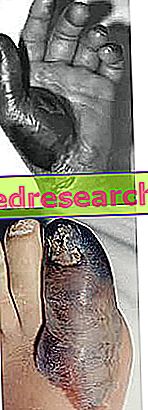Definition of gangrene
Gangrene (or gangrene) is a pathological condition characterized by the literal massive putrefaction of one or more body tissues. This is a terribly worrying clinical urgency because - due to the lack of blood flow - the gangrenous tissue inevitably dies (tissue necrosis). Often, due to insufficient blood supply, the gangrene-affected tissue is then rapidly invaded by bacteria.
Although manifesting itself generally in the extremities of the body (hands, feet and fingers), gangrene can also damage muscles and internal organs (common is the gangrene of the appendix). The risk of gangrene increases exponentially in the presence of pathological conditions that affect the blood and damage blood vessels, in particular diabetes and atherosclerosis.
The patient's prognosis is good only when the gangrene is diagnosed early and treated early with heavy antibiotics and / or surgery: in all other cases, the patient undergoes death.
Causes and types of gangrene
According to the triggering cause, we mainly distinguish three types of gangrene:- DRIED CANCRENE : gradual but inexorable, dry gangrene is induced by ischemia, that is by a reduction / block of blood flow in the arteries in certain areas of the body (in particular at the extremities of the limbs). In most cases, patients suffering from this form of gangrene do not have infections (because bacteria have difficulty surviving and only minimally proliferate). The cause is rather sought after in metabolic diseases or predisposing conditions such as in particular:
- Atherosclerosis and diabetes (especially), see diabetic foot, more common in the elderly
- Thrombosis of arterial vessels
- Hypercholesterolemia
- smoking
- Genetic predisposition: this factor can also play a major role in the appearance of diseases that predispose to gangrene.
In the dry variant, the affected fabric undergoes an evident chromatic variation: this in fact can take on a pale color, bluish, violet, red or even black (the color variation depends on the type of pathology that caused gangrene). Dry gangrene spreads slowly until it reaches an area where the blood supply is able to keep tissues alive; in this area it stops.
Curiosity
The chromatic variation caused by gangrene is mainly due to the release of hemoglobin from red blood cells, induced in turn by the production of hydrogen sulphide by bacteria. In this way, iron sulfide is formed which, stagnating in the tissues, gives the typical black or red color.
The affected area also becomes cold, dry, numbed and numb, much like a limb of a mummy.

Dry gangrene is the death of a tissue without infectious overlap. It is characterized by dehydration and mummification of necrotized tissues.
When not surgically removed, the affected limb tends to detach spontaneously. For this reason, dry gangrene is generally not considered an urgency; however, the risk of infection of necrotic tissues with consequent transformation into wet gangrene should be mentioned. Furthermore, if dry gangrene is diagnosed in time, the limb can sometimes be saved by vascular surgery. In the most serious cases, the limb is amputated.
- WET OR WET CANCRENE : typical complication of an infected wound and inadequately treated, wet gangrene affects areas such as the buccal mucosa, lungs, intestine, cervix and vulva. Also in this case, as inherent in the concept of gangrene itself, blood flow stops in the affected area; however, unlike the previous case, ischemia does not depend on occlusive processes but on vessel damage caused by trauma and bacterial infections.

Curiosity
Even bedsores, although dry, can be considered a form of wet gangrene.
The tissue affected by wet gangrene is targeted by bacteria (eg Clostridium perfringens or Bacillus fusiformis ); consequently, it starts to swell, at the same time giving off a very unpleasant smell of rot due to the blood that stagnates. Moist gangrene tends to spread rather quickly due to the venous and arterial blood block: the bacteria that stagnate in this area proliferate very rapidly, up to septicemia (blood infection).
The tissue affected by soft gangrene is rotten, edematous and dark in color. Unlike dry gangrene, the wet one is a real urgency that must be treated immediately with surgery (cleaning of the infected tissue in the operating room) and with vein antibiotics (usually multiple). The risk, in fact, is not limited to the loss of the limb but also concerns the danger of losing one's life.
- GASEOUS CANCER : it is a bacterial infection that causes the formation of gas inside the tissues. The main cause appears to be an exotoxin produced by clostridia (of which Clostridium perfringens appears to be the most dangerous). These environmental bacteria penetrate the human body through a wound: when they reach the body, they begin to proliferate indiscriminately, secreting powerful and lethal toxins. Spreading rapidly, the gases produced by the bacteria infiltrate the neighboring tissues: in this way, the damage spreads like an oil stain. Gas gangrene can cause tissue necrosis, sepsis (or septicemia), toxaemia (presence in the blood of substances in concentrations toxic to the body) and septic shock. Also in this case it is therefore a real medical urgency.
Other types of gangrene
Among the various forms of gangrene we cannot forget the necrotizing fasciitis, a violent and sudden infection that affects the soft tissues. Infection is generally caused by bacteria such as group A streptococcus β-haemolytics, staphylococci (especially Staphylococcus aureus ) and anaerobes belonging to the genus Clostridium .
Also the perineal phlegmon (also called Fournier's Gangrena) is a terrible form of gangrene affecting the male genitalia, caused by Streptococcus pyogenes and other germs such as Klebsiella, E. coli and clostridia.
We cannot forget Noma (gangrenous stomatitis), a type of gangrene that deteriorates and destroys the face, in particular the cheeks and the mouth. This form of gangrene, which mainly affects children who are immunosuppressed or malnourished, is responsible for exaggerated damage to the face: affected children are disfigured by the disease, to the point of even showing bones and teeth.




